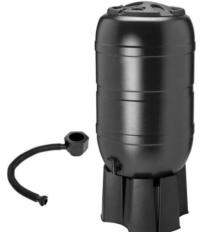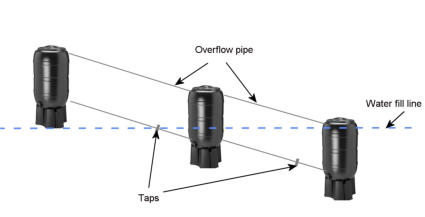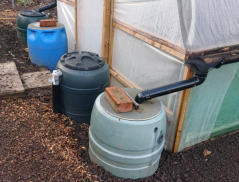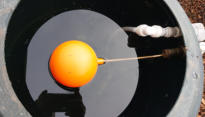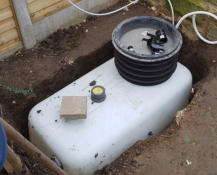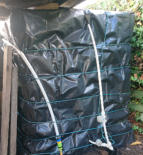

Email: graham@gardeningwithgraham.com
Terms and conditions
Follow on Instagram: gardening_with_graham_and_pam
© Gardeningwithgraham.com 2023


Rainwater
Droughts really make you think a little bit more about the water situation in our gardens. This year (2022) has been a particularly bad year as far as rain is concerned, with low rainfall in winter followed by heatwaves throughout spring and summer. As the reservoir water levels fell it was inevitable that the water companies would introduce hosepipe bans. Although some water companies have started to lift this due to the heavy rainfall of October and November the reservoirs are still low. It is nice to be able to connect the hosepipe to the tap stick a sprinkler on the end and just leave it on to water your garden. Yes if you are on a meter, as more and more of us are now, it will cost you a little more for the water, the convenience is great. What if we continue to get years like this? There will not be many now that have not heard about climate change and the expected effects this will have on the planet from heavy rainfalls causing floods to droughts causing famine. So what can we expect in our gardens? Well probably drier summers and wetter winters. The ways in which we deal with this will play a large part in how successful we are in our gardens and how often we have water shortages and have to face hosepipe bans. Here we will look at ways in which you can help and maybe reduce your water bill at the same time. We have several methods used both in our gardens and at the allotment for collecting and storing rainwater I will go through some options as well as what we have in place and how we have use the rainwater collected.Collection and storage
Collection to a water butt
The simplest way to start collecting rainwater is to use a rainwater kit. There are many kits for collecting rainwater from your roof. These usually comprise of a water butt, stand and a downpipe rainwater diverter. Small kits can be purchased relatively cheaply but the the price can go up considerably for much bigger kits. These are ideal for a few pots around, the garden the one in the image stores 210 litres which can last a few weeks. We have one of this size next to the house used to water a few pots and parts of the lawn amongst the paving that dries out too fast but ours is not set up in the typical fashion. Whereas a downpipe rainwater diverter is designed to allow rainwater (and debris) to pass through once the butt is full, we have connected the downpipe directly to the butt so that we collect all the rainwater and have an overflow to the side for when this is full. The downpipe has been fitted in such a way that I can convert from rainwater collection to grey waste collection during the drier parts of the year. This allows me to collect bath, shower and hand washing water from our bathroom. The down side to this is a build up of sediment in the bottom of the water butt which I have to periodically clear out. If you need more water you can link several water butts together and again there are simple connection kits available. These connect at the top as an overflow so that when one water butt is full it starts to overflow to the next and so on for how ever many you have connected. This is great for most people but where I have multiple water butts connected both at home and on the allotment this would not work. Here are my examples and how I have dealt with it:- Potting shed The water butts by our potting shed collect rainwater from the green roof. We wanted to use this rainwater to water our vegetable beds at the top of our garden using a watering can. The position of the lower water butt is in the perfect position between the vegetable beds the other two help to feed water to this. What I have done is link each with an overflow so that when the uppermost water butt fills it then overflows to fill the second and finally the third. In order for me to use the water from the lowest butt these have been linked at the bottom. So that each water butt can fill fully I have installed an isolation tap between the butts. The isolation tap is vital otherwise the upper two water buts would only ever fill to the overflow height of the lowest butt (water fill line in the diagram). During use I will drain the first water butt, when this is empty I open the tap (positioned just behind the butt shown in the picture) which then allows the water from the middle butt to flow and refill the bottom butt. When the water butt is empty again I then open the tap isolating the top butt and again this will refill the bottom butt. I leave both taps open at this point to allow the rain to keep the bottom butt topped up. Once the rain starts to become more frequent I will close the taps and allow the butts to fill in overflow mode again. Polytunnel Here I wanted to be able to use one water butt (the blue butt) for dunking watering cans into, but also allow all four to feed the watering system for the polytunnel. The rainwater is collected from the polytunnel on both sides. I have linked all four water butts at the base and placed all the water butts level so that effectively they act as one big water butt. This means that any water used comes from all four equally and also when filling all four fill equally giving me the equivalent to a single tank of about 850 litres. The link to each tank is actually about 10cm from the bottom due to the curved nature of the water butts. By setting it up in this way any debris caught on the bottom of the watering cans should stay in the water butt used for dunking and I will, once a year clear out the bottom. The water butt used to supply the watering system has a pipe installed with a filter on the end to help prevent debris entering and blocking the watering system, This water butt also has a pipe feed from an IBC (1000 litre water tank) that is installed further up the allotment behind the shed. This pipe has a ballcock valve installed, so that as the water in the water butts is used by the watering system it is kept topped up for a while by the IBC. Using it this way allows several weeks of unsupervised watering in the polytunnel, ideal for when on holiday.Collection to a larger storage tank
This is something that would ideally be planned when starting the garden. It is possible to get tanks that hold many thousands of litres of water and have these collect all your rainwater run off. With a system like this you should filter the water before it enters the storage tank to try reduce sediment build up, this could be something as simple as a small collection tank with overflow and mesh covering. This way the mesh filters out the big stuff such as leaves, then finer stuff such as soil, sand etc. should settle in the collection tank and the cleaner water would then overflow to the main storage tank. This is not perfect but should vastly reduce the sediment collected. These sorts of large collection systems are often used to provide water for toilet flushing as well as the garden and are sometimes installed on custom new build houses. A more affordable option is to use IBC’s (intermediate bulk container), these are used everywhere for shipping large volumes of liquid and can often be bought quite cheaply on Ebay. When buying for use in the garden it is worth checking what the container was used for previously as many are used for chemicals that you would not want in your garden, some of which you would definitely not want getting into your food. If you have the money you can also buy these new.My home larger storage tank
Most of us do not have the luxury to have one of above underground storage units installed but that does not mean we cannot have more storage hidden away. I have a 1200 litre water storage tank (bought second hand from Ebay), that I buried in the garden, this collects rainwater from the greenhouse, garage and folly using a very basic metal mesh filter to remove the larger sediment. The plan behind this was to use the rainwater to water the greenhouse and to keep the ponds topped up throughout the summer months. In order for me to use this water I have a water butt pump connected to permanent pipes, I can then just switch the pump on and open the appropriate tap.An IBC (at the allotment)
At the allotment I have used an IBC raised on a dry stone base to use as a water tower (shown in the picture on the left). This collects rainwater from the shed and is used to top water butts and bins around the allotment using gravity and hose pipes. I have covered the container with black damp proofing membrane (as seen in the picture to the right) to reduce the amount of light getting into the tank, thus reducing the build up of algae. The water is fed into the IBC from the gutter with the down pipe having a metal mesh filter at the top to prevent sediment such as leaves entering the tank. I have also connected a permanent feed from this to the water butts outside the polytunnel and to a hose connection point at the lower end of the plot. These are just a few of the ways in which rainwater can be collected and stored in the garden. With a bit of imagination you will be able to work out a way to store and use rainwater in your garden, doing your bit for the environment and hopefully save you some money in the long run too.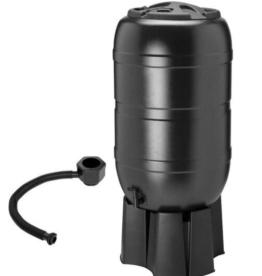
Typical
water butt
kit
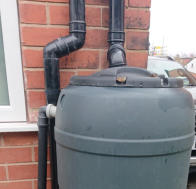
Our system, the left pipe can
be diverted to the water butt.
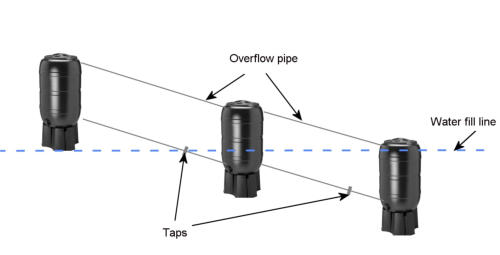
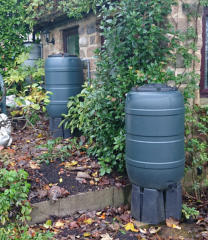
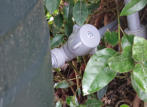
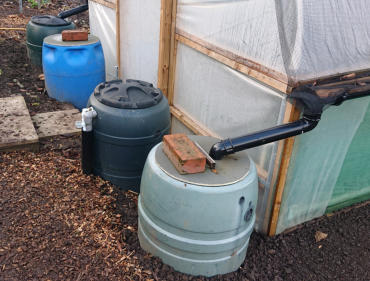
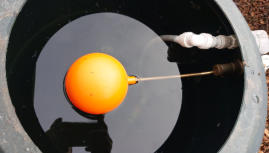
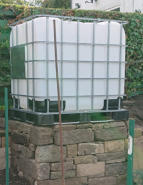
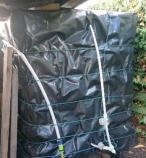
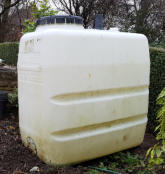
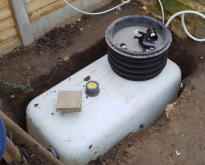


Email: graham@gardeningwithgraham.com
Terms and conditions
Follow on Instagram: gardening_with_graham_and_pam
© Graham Clark 2022


Rainwater
Droughts really make you think a little bit more about the water situation in our gardens. This year (2022) has been a particularly bad year as far as rain is concerned, with low rainfall in winter followed by heatwaves throughout spring and summer. As the reservoir water levels fell it was inevitable that the water companies would introduce hosepipe bans. Although some water companies have started to lift this due to the heavy rainfall of October and November the reservoirs are still low. It is nice to be able to connect the hosepipe to the tap stick a sprinkler on the end and just leave it on to water your garden. Yes if you are on a meter, as more and more of us are now, it will cost you a little more for the water, the convenience is great. What if we continue to get years like this? There will not be many now that have not heard about climate change and the expected effects this will have on the planet from heavy rainfalls causing floods to droughts causing famine. So what can we expect in our gardens? Well probably drier summers and wetter winters. The ways in which we deal with this will play a large part in how successful we are in our gardens and how often we have water shortages and have to face hosepipe bans. Here we will look at ways in which you can help and maybe reduce your water bill at the same time. We have several methods used both in our gardens and at the allotment for collecting and storing rainwater I will go through some options as well as what we have in place and how we have use the rainwater collected.Collection and storage
Collection to a water butt
The simplest way to start collecting rainwater is to use a rainwater kit. There are many kits for collecting rainwater from your roof. These usually comprise of a water butt, stand and a downpipe rainwater diverter. Small kits can be purchased relatively cheaply but the the price can go up considerably for much bigger kits. These are ideal for a few pots around, the garden the one in the image stores 210 litres which can last a few weeks. We have one of this size next to the house used to water a few pots and parts of the lawn amongst the paving that dries out too fast but ours is not set up in the typical fashion. Whereas a downpipe rainwater diverter is designed to allow rainwater (and debris) to pass through once the butt is full, we have connected the downpipe directly to the butt so that we collect all the rainwater and have an overflow to the side for when this is full. The downpipe has been fitted in such a way that I can convert from rainwater collection to grey waste collection during the drier parts of the year. This allows me to collect bath, shower and hand washing water from our bathroom. The down side to this is a build up of sediment in the bottom of the water butt which I have to periodically clear out. If you need more water you can link several water butts together and again there are simple connection kits available. These connect at the top as an overflow so that when one water butt is full it starts to overflow to the next and so on for how ever many you have connected. This is great for most people but where I have multiple water butts connected both at home and on the allotment this would not work. Here are my examples and how I have dealt with it:- Potting shed The water butts by our potting shed collect rainwater from the green roof. We wanted to use this rainwater to water our vegetable beds at the top of our garden using a watering can. The position of the lower water butt is in the perfect position between the vegetable beds the other two help to feed water to this. What I have done is link each with an overflow so that when the uppermost water butt fills it then overflows to fill the second and finally the third. In order for me to use the water from the lowest butt these have been linked at the bottom. So that each water butt can fill fully I have installed an isolation tap between the butts. The isolation tap is vital otherwise the upper two water buts would only ever fill to the overflow height of the lowest butt (water fill line in the diagram). During use I will drain the first water butt, when this is empty I open the tap (positioned just behind the butt shown in the picture) which then allows the water from the middle butt to flow and refill the bottom butt. When the water butt is empty again I then open the tap isolating the top butt and again this will refill the bottom butt. I leave both taps open at this point to allow the rain to keep the bottom butt topped up. Once the rain starts to become more frequent I will close the taps and allow the butts to fill in overflow mode again. Polytunnel Here I wanted to be able to use one water butt (the blue butt) for dunking watering cans into, but also allow all four to feed the watering system for the polytunnel. The rainwater is collected from the polytunnel on both sides. I have linked all four water butts at the base and placed all the water butts level so that effectively they act as one big water butt. This means that any water used comes from all four equally and also when filling all four fill equally giving me the equivalent to a single tank of about 850 litres. The link to each tank is actually about 10cm from the bottom due to the curved nature of the water butts. By setting it up in this way any debris caught on the bottom of the watering cans should stay in the water butt used for dunking and I will, once a year clear out the bottom. The water butt used to supply the watering system has a pipe installed with a filter on the end to help prevent debris entering and blocking the watering system, This water butt also has a pipe feed from an IBC (1000 litre water tank) that is installed further up the allotment behind the shed. This pipe has a ballcock valve installed, so that as the water in the water butts is used by the watering system it is kept topped up for a while by the IBC. Using it this way allows several weeks of unsupervised watering in the polytunnel, ideal for when on holiday.Collection to a larger storage tank
This is something that would ideally be planned when starting the garden. It is possible to get tanks that hold many thousands of litres of water and have these collect all your rainwater run off. With a system like this you should filter the water before it enters the storage tank to try reduce sediment build up, this could be something as simple as a small collection tank with overflow and mesh covering. This way the mesh filters out the big stuff such as leaves, then finer stuff such as soil, sand etc. should settle in the collection tank and the cleaner water would then overflow to the main storage tank. This is not perfect but should vastly reduce the sediment collected. These sorts of large collection systems are often used to provide water for toilet flushing as well as the garden and are sometimes installed on custom new build houses. A more affordable option is to use IBC’s (intermediate bulk container), these are used everywhere for shipping large volumes of liquid and can often be bought quite cheaply on Ebay. When buying for use in the garden it is worth checking what the container was used for previously as many are used for chemicals that you would not want in your garden, some of which you would definitely not want getting into your food. If you have the money you can also buy these new.My home larger storage tank
Most of us do not have the luxury to have one of above underground storage units installed but that does not mean we cannot have more storage hidden away. I have a 1200 litre water storage tank (bought second hand from Ebay), that I buried in the garden, this collects rainwater from the greenhouse, garage and folly using a very basic metal mesh filter to remove the larger sediment. The plan behind this was to use the rainwater to water the greenhouse and to keep the ponds topped up throughout the summer months. In order for me to use this water I have a water butt pump connected to permanent pipes, I can then just switch the pump on and open the appropriate tap.An IBC (at the allotment)
At the allotment I have used an IBC raised on a dry stone base to use as a water tower (shown in the picture on the left). This collects rainwater from the shed and is used to top water butts and bins around the allotment using gravity and hose pipes. I have covered the container with black damp proofing membrane (as seen in the picture to the right) to reduce the amount of light getting into the tank, thus reducing the build up of algae. The water is fed into the IBC from the gutter with the down pipe having a metal mesh filter at the top to prevent sediment such as leaves entering the tank. I have also connected a permanent feed from this to the water butts outside the polytunnel and to a hose connection point at the lower end of the plot. These are just a few of the ways in which rainwater can be collected and stored in the garden. With a bit of imagination you will be able to work out a way to store and use rainwater in your garden, doing your bit for the environment and hopefully save you some money in the long run too.
Our system, the left
pipe can be diverted
to the water butt.

